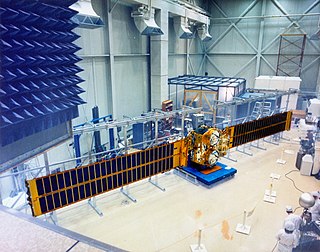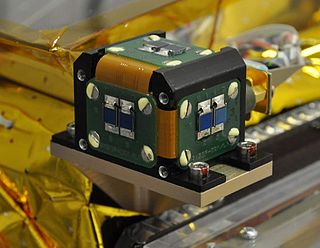A resistojet is a method of spacecraft propulsion that provides thrust by heating a typically non-reactive fluid. Heating is usually achieved by sending electricity through a resistor consisting of a hot incandescent filament, with the expanded gas expelled through a conventional nozzle.
High Energy Transient Explorer 1 (HETE-1) was a NASA astronomical satellite with international participation.
The Microvariability and Oscillations of Stars/Microvariabilité et Oscillations STellaire (MOST), was Canada's first space telescope. Up until nearly 10 years after its launch it was also the smallest space telescope in orbit. MOST was the first spacecraft dedicated to the study of asteroseismology, subsequently followed by the now-completed CoRoT and Kepler missions. It was also the first Canadian science satellite launched since ISIS II, 32 years previously.

The Communications Technology Satellite (CTS), known as Hermes, was an experimental high-power direct broadcast communications satellite. It was a joint effort of Canadian Department of Communications, who designed and built the satellite, NASA who tested, launched and operated the satellite, and European Space Agency (ESA) who provided the 1200 watts solar panels and other devices. The three agencies shared the satellite and the data from the experiments.

A small satellite, miniaturized satellite, or smallsat is a satellite of low mass and size, usually under 1,200 kg (2,600 lb). While all such satellites can be referred to as "small", different classifications are used to categorize them based on mass. Satellites can be built small to reduce the large economic cost of launch vehicles and the costs associated with construction. Miniature satellites, especially in large numbers, may be more useful than fewer, larger ones for some purposes – for example, gathering of scientific data and radio relay. Technical challenges in the construction of small satellites may include the lack of sufficient power storage or of room for a propulsion system.

A sun sensor is a navigational instrument used by spacecraft to detect the position of the sun. Sun sensors are used for attitude control, solar array pointing, gyro updating, and fail-safe recovery.

Space Technology 5 (ST5) of the NASA New Millennium program was a test of ten new technologies aboard a group of microsatellites. Developed by NASA Goddard Space Flight Center, the three individual small spacecraft were launched together from the belly of a Lockheed L-1011 aboard the Pegasus XL rocket, on 22 March 2006. One technology involved antennas that were designed by computers using an evolutionary AI system developed at NASA Ames Research Center. The ST5 on-board flight computer, the C&DH system, was based on a Mongoose-V radiation-hardened microprocessor.
PICARD is a satellite dedicated to the simultaneous measurement of the absolute total and spectral solar irradiance, the diameter and solar shape, and to the Sun's interior probing by the helioseismology method. These measurements obtained throughout the mission allow study of their variations as a function of solar activity. It launched, along with the Prisma spacecraft, on 15 June 2010 on a Dnepr launcher from Dombarovskiy Cosmodrome, near Yasny, Russia. The mission, originally planned for two years, ended on 4 April 2014.
The Near Earth Object Surveillance Satellite (NEOSSat) is a Canadian microsatellite using a 15-cm aperture f/5.88 Maksutov telescope, with 3-axis stabilisation giving a pointing stability of ~2 arcseconds in a ~100 second exposure. It is funded by the Canadian Space Agency (CSA) and Defence Research and Development Canada (DRDC), and searches for interior-to-Earth-orbit (IEO) asteroids, at between 45 and 55 degree solar elongation and +40 to -40 degrees ecliptic latitude.
MightySat-2.1, also known as P99-1 or Sindri was a small spacecraft developed by the Air Force Research Laboratory to test advanced technologies in imaging, communications, and spacecraft bus components in space.
SSETI Express was the first spacecraft to be designed and built by European students and was launched by the European Space Agency. SSETI Express is a small spacecraft, similar in size and shape to a washing machine. On board the student-built spacecraft were three CubeSat picosatellites, extremely small satellites weighing around one kg each. These were deployed one hour and forty minutes after launch. Twenty-one university groups, working from locations spread across Europe and with very different cultural backgrounds, worked together via the internet to jointly create the satellite. The expected lifetime of the mission was planned to be 2 months. SSETI Express encountered an unusually fast mission development: less than 18 months from kick-off in January 2004 to flight-readiness.
SOCRATES or Space Optical Communications Research Advanced Technology Satellite is a Japanese micro-satellite launched in 2014. The satellite is purely a technology demonstrator designed by NICT intended to help AES company to gain experience in basic mission control, attitude control and spacecraft communications. Its main experiment is SOTA, an optical small satellite communications demonstrator. All subsystems of spacecraft are powered by solar cells mounted on spacecraft body and stub wings, with estimated electrical power of 120W BOL degrading to 100W EOL.
Reimei ('Dawn') is the in-flight name for a small Japanese satellite known during development as INDEX, developed in-house at JAXA both to serve as a demonstration of small-satellite technologies and to perform simultaneous optical and charged-particle observation of the aurora. A notable feature is the 25 μm-thick polyimide mirrors used for concentrating sunlight onto the solar arrays.

ASTERIA was a miniaturized space telescope technology demonstration and opportunistic science mission to conduct astrophysical measurements using a CubeSat. It was designed in collaboration between the Massachusetts Institute of Technology (MIT) and NASA's Jet Propulsion Laboratory. ASTERIA was the first JPL-built CubeSat to have been successfully operated in space. Originally envisioned as a project for training early career scientists and engineers, ASTERIA's technical goal was to achieve arcsecond-level line-of-sight pointing error and highly stable focal plane temperature control. These technologies are important for precision photometry, i.e., the measurement of stellar brightness over time. Precision photometry, in turn, provides a way to study stellar activity, transiting exoplanets, and other astrophysical phenomena.
EQUULEUS is a nanosatellite of the 6U CubeSat format that will measure the distribution of plasma that surrounds the Earth (plasmasphere) to help scientists understand the radiation environment in that region. It will also demonstrate low-thrust trajectory control techniques, such as multiple lunar flybys, within the Earth-Moon region using water steam as propellant. The spacecraft was designed and developed jointly by the Japan Aerospace Exploration Agency (JAXA) and the University of Tokyo.
The Innovative Satellite Technology Demonstration Program is a series of spacecraft missions for testing technology and ideas put forward by universities and private companies. The program demonstrates various experimental devices and technology in space by providing flight opportunities. It is managed by the JAXA Research and Development Directorate. According to JAXA, the goal of this program is to test high risk, innovative technology that will lead to the space industry gaining competitiveness in the international field.
RAPIS-1 is a satellite launched on 18 January 2019 which for over a year was used to test seven technology demonstration projects. RAPIS-1 was developed and operated by Axelspace Corporation, under the coordination of the Japanese space agency JAXA.
NASA's Pathfinder Technology Demonstrator (PTD) Project will test the operation of a variety of novel technologies on a type of nanosatellites known as CubeSats, providing significant enhancements to the performance of these versatile spacecraft. Each of the five planned PTD missions consist of a 6-unit (6U) CubeSat with expandable solar arrays.

TSUBAME was a microsatellite developed by the Tokyo Institute of Technology and Tokyo University of Science from a student design concept in 2004. The satellite was designed to demonstrate new technologies for rapid attitude control, observing gamma ray bursts, and earth observation. The name, TSUBAME, means swift in Japanese and was chosen both because of the experimental attitude control system and to invoke another gamma ray observatory, the Swift Gamma-Ray Burst Mission, which launched shortly after TSUBAME's first design concept was published in 2004.

The Nanosat 01, sometimes written as NanoSat-1 or NanoSat 01, was an artificial satellite developed by the Spanish Instituto Nacional de Técnica Aeroespacial (INTA) and launched the 18th of December 2004. Considered a nano satellite for its weight of less than 20 kg, its main mission was forwarding communications between far reaching points of the Earth such as Juan Carlos I Antarctic Base from mainland Spain. This was possible due to its polar orbit and altitude of 650 km above sea level. During an operational run the data obtained in the Antarctic would be uploaded to the satellite during its fly by and then, downloaded in Spain when satellite reached the Iberian Peninsula.






